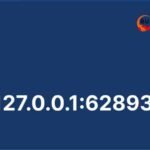The combination of 127.0.0.1 with port 49342 refers to a communication system within your computer. The IP 127.0.0.1, often called localhost, serves as a special address that your computer uses to talk to itself. This communication stays within the device and doesn’t leave the system to access the internet. The 49342 part represents a port number, which functions like a doorway for specific applications or services running on your machine. Using this combination, your computer can perform tests, run services locally, and debug software without needing an external network connection.
Table of Contents
Why Use 127.0.0.1:49342?
Using 127.0.0.1:49342 allows developers and system administrators to run services securely on their local machine. It provides a safe testing environment for applications, ensuring that no sensitive data or software bugs are exposed to the internet. Developers often use this combination to simulate real-world scenarios, like testing APIs, before deploying them live. Because localhost communication stays within the computer, it ensures fast performance and avoids network-related delays, making it essential for troubleshooting and refining applications. Additionally, the use of this specific port helps organize multiple services without conflicts.
Understanding the Significance of Port 49342
Port 49342 plays an important role by acting as a gateway for communication between services or applications running on the same machine. In complex environments, such as those with web servers or APIs, every service requires a unique port to function properly and avoid conflicts. Port 49342 is often used in development environments for testing web services and virtual machines. The ability to assign dedicated ports ensures better resource management, reduces errors, and helps maintain clear separation between running services. This makes development smoother and keeps applications isolated.
How 127.0.0.1:49342 Works
When a service uses 127.0.0.1:49342, the data being sent stays entirely on the local machine. This means a computer sends data to itself on port 49342 without involving external networks. For example, a developer might run a local web server that listens for requests on port 49342. This configuration ensures fast and secure communication between services without opening the computer to outside risks. By assigning services to specific ports, developers ensure smooth inter-process communication and make troubleshooting easier, especially in environments with multiple active services.
Setting Up 127.0.0.1:49342 on Your Machine

To use 127.0.0.1:49342, first install server software like Apache or Nginx and configure it to listen on port 49342. On some setups, Docker or virtual machines can also be configured to use this port for local development. Open the server’s configuration file and specify 127.0.0.1:49342 as the address and port for listening. Save the configuration, restart the service, and test the setup by opening a browser and navigating to http://127.0.0.1:49342. If everything is set correctly, the local service will be visible, showing that your machine is successfully running on this port.
Common Use Cases for 127.0.0.1:49342
Developers frequently use 127.0.0.1:49342 to test web applications locally before deploying them to production servers. This ensures all features are working correctly in a safe and isolated environment. Virtual machines also use such ports to establish internal communication during development. Additionally, APIs being tested can run on this port to avoid conflicts with other services. Testing environments for databases often rely on localhost configurations like this, helping developers identify and resolve issues before they affect users on live networks.
Security Considerations with 127.0.0.1:49342
Although 127.0.0.1:49342 is isolated from the internet, it is still essential to implement security measures. Misconfigured services running on this port may expose sensitive data to other processes on the same machine. Firewall rules should be in place to ensure only trusted applications access it. Additionally, developers should scan for vulnerabilities regularly, keep software updated, and use secure configurations. When working on shared systems, using password authentication and monitoring logs for unauthorized activity helps maintain a safe local environment.
Troubleshooting 127.0.0.1:49342 Issues
Issues with 127.0.0.1:49342 often arise from port conflicts or misconfigured services. If an application fails to run, check whether another service is already using port 49342 by running commands like netstat or lsof. Firewall rules might also block communication, so ensuring that the port is open for local traffic is essential. Restarting the service or changing the port to another unused number can also resolve conflicts. Log files are helpful for diagnosing problems and can show where the service is encountering errors during startup or connection attempts.
Benefits of Using 127.0.0.1:49342

Running services on 127.0.0.1:49342 offers several benefits, including faster development cycles and better security. Developers can quickly build and test software locally without worrying about network issues or security risks associated with public servers. Because services on localhost don’t involve external networks, they have low latency, leading to faster performance. Using this port also helps avoid downtime in production environments, as bugs can be resolved during the testing phase. This approach ensures smooth deployments and better overall application stability.
Difference Between 127.0.0.1 and Other Private IPs
While 127.0.0.1 refers specifically to the local machine (localhost), other private IPs like 192.168.x.x allow communication between devices on the same network. For example, 192.168.1.1 might be used to access a router, while 127.0.0.1 is only for internal communication within a single computer. The main difference is that localhost traffic never leaves the device, ensuring secure and private communication. Private IP addresses, on the other hand, enable networking among multiple devices, such as in a home or office network.
Configuring Services to Use Port 49342
To configure a service on 127.0.0.1:49342, open the application’s settings or configuration file and assign the port number 49342. Make sure no other service is using the same port to avoid conflicts. If you are using a web server like Apache, you can edit the httpd.conf file to specify the listening port. Restart the service after saving changes. It’s important to test the service by navigating to http://127.0.0.1:49342 in your browser to confirm the configuration is correct and that the service is running smoothly.
Optimizing Performance with Localhost and Port Management
Managing services efficiently on 127.0.0.1:49342 requires careful resource management. Running too many services on the same machine can cause CPU and memory overloads, leading to slowdowns. It’s helpful to monitor resource usage with tools like Task Manager or htop on Linux. Assigning separate ports for each service ensures there are no conflicts, improving overall system stability. Regularly restarting services that consume too many resources also helps maintain performance. By optimizing port management, developers can prevent downtime and keep services running efficiently.
Common Errors and Their Fixes
Some common errors with 127.0.0.1:49342 include “port already in use” and connection refused messages. These occur when multiple services attempt to use the same port or when firewall settings block the port. Restarting the service or assigning a different port can resolve the issue. Additionally, checking firewall rules ensures the port is open for local traffic. If services aren’t starting, examining log files can reveal configuration errors or missing dependencies. Regular monitoring helps catch these issues early and ensures smooth operations.
FAQs
- Can other devices access 127.0.0.1:49342?
No, only the local machine can access this address and port. - What happens if two services use port 49342?
The services will conflict, and one may fail to start. - Is it safe to expose 127.0.0.1:49342 to the internet?
No, it is intended for local communication only and should remain isolated.
Real-World Scenarios Using 127.0.0.1:49342

Developers commonly use 127.0.0.1:49342 to test new websites and APIs before public release. Virtual machines running multiple services also benefit from isolated communication using custom ports like 49342. For example, a Docker container can be configured to use this port for backend service testing. These scenarios allow developers to work in a safe environment without risking production environments. By isolating these processes, teams ensure better quality control and faster troubleshooting.
Best Practices for Using 127.0.0.1:49342 Safely
To use 127.0.0.1:49342 securely, always implement firewalls and access controls to limit unauthorized access. Keep your software and services updated to prevent vulnerabilities. Monitoring log files helps detect suspicious activities, and regularly restarting services ensures smooth operations. Avoid exposing localhost services to the internet, as they are meant for local testing only. Following these practices ensures secure and efficient use of localhost ports like 49342.
Conclusion
Mastering the use of 127.0.0.1:49342 enables developers to build, test, and troubleshoot applications efficiently. This IP-port combination ensures secure communication within the local machine, preventing unnecessary exposure to external risks. Whether you’re developing APIs, setting up web servers, or managing virtual machines, using localhost ports ensures smooth performance and safer deployments. Understanding this concept is essential for anyone involved in **public deployment. With the right tools and strategies in place, developers and IT professionals can create a seamless development process, making 127.0.0.1:49342 a cornerstone for efficient local operations.
Read More : Fastrac Ontrac







